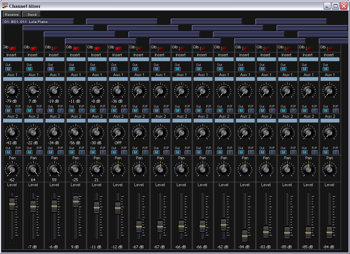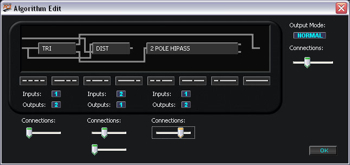The newest member of the PC3 family, the PC361 is a powerful digital modular synthesizer, representing Kurzweil's return to leading the music scene and the supremacy of VAST synthesis. Welcome to the extreme test…
The newest member of the PC3 family, the PC361 is a powerful digital modular synthesizer, representing Kurzweil’s return to leading the music scene and the supremacy of VAST synthesis. Welcome to the extreme test…
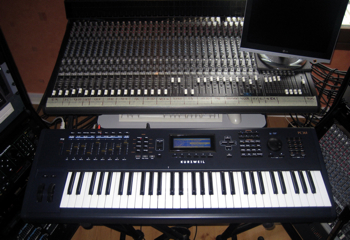 In the early 80‘s, Raymond Kurzweil, known for his works on speech recognition for blind people, was solicited by a famous artist: “I want a keyboard that is able to reproduce the sound of real instruments, is easy to use, and pleasant to play”. With the inspiration of Stevie Wonder, the K250 was released in 1982. Next came the K150, a separate expander, based on resynthesis and Fourier transformation. In 10 years, there followed a prolific series of synths (keyboards and expanders) for sample playback: the K1000 series. In the early 90‘s, Kurzweil was purchased by Young Chang, and Ray jumped ship. The corporation then unveiled a revolutionary workstation: the K2000. A true modular digital synth, based on an analog model, the machine relied on proprietary VLSI chips. It was produced for 8 years, never ceasing to evolve, becoming a powerful sampler. The series became larger with the K2500/2600/2661, bringing more power, more DSP (processor of KDFX effects), more Rom and triple-mode modularity. The OS never stopped evolving, adding new features along the way, including a tonewheel organ model, thus avoiding obsolescence. In parallel, Kurzweil developed a range of high end digital pianos, effects processors, and performance keyboards.
In the early 80‘s, Raymond Kurzweil, known for his works on speech recognition for blind people, was solicited by a famous artist: “I want a keyboard that is able to reproduce the sound of real instruments, is easy to use, and pleasant to play”. With the inspiration of Stevie Wonder, the K250 was released in 1982. Next came the K150, a separate expander, based on resynthesis and Fourier transformation. In 10 years, there followed a prolific series of synths (keyboards and expanders) for sample playback: the K1000 series. In the early 90‘s, Kurzweil was purchased by Young Chang, and Ray jumped ship. The corporation then unveiled a revolutionary workstation: the K2000. A true modular digital synth, based on an analog model, the machine relied on proprietary VLSI chips. It was produced for 8 years, never ceasing to evolve, becoming a powerful sampler. The series became larger with the K2500/2600/2661, bringing more power, more DSP (processor of KDFX effects), more Rom and triple-mode modularity. The OS never stopped evolving, adding new features along the way, including a tonewheel organ model, thus avoiding obsolescence. In parallel, Kurzweil developed a range of high end digital pianos, effects processors, and performance keyboards.
After several years in the weeds, taken for a ride by the strategic and technological choices of Young Chang, a devastating stock market rush by Samick, and finally purchased by Hyundai, the horizon for Kurzweil seems today be clearer. The R&D reformed around certain mainstays of the company (see R&D Box), Ray Kurzweil is associated with the strategy of the head office, and once again a new product is on the market: the PC3. More good news, the distribution in France has been recently rebuilt, after a total absence for years due to the disappearance of the preceding French importer and to the epic fight between the German and Danish importers. The latest product, the PC361, is the all new version of the performance keyboard by Kurzweil. But let us not cheat ourselves here: under the name performance keyboard hides in fact a true synthesizer, VASTer than ever.
Solid Shell
 Similar in appearance to the K2661, the PC361 is housed in a solid metallic chassis classily coloured indigo, with glossy buttons. The yellow, white and blue coloured print has a very beautiful effect and easy to read. On the left, after the volume fader, one finds 9 long faders and 9 dedicated push buttons that command in real time the internal parameters or those of external units, according to saved settings with every program. The choice of 9 is intended for tone wheel organ modelling with pull-down drawbars, which we will cover later. Further to the right are the buttons dedicated to play modes and sequencer commands. Next comes a monochrome nostalgic style blue backlit 240 × 64 pixels LCD with adjustable brightness and contrast. To the right of the screen are 2 arrays of 40 buttons around a big encoder, allowing for smooth navigation within different sound banks with category and program number selection, and detailed editing of parameters. For cheek-block controllers, one finds 2 wheels and 2 buttons (a dedicated one for arpegiator enabling and a free assignable one).
Similar in appearance to the K2661, the PC361 is housed in a solid metallic chassis classily coloured indigo, with glossy buttons. The yellow, white and blue coloured print has a very beautiful effect and easy to read. On the left, after the volume fader, one finds 9 long faders and 9 dedicated push buttons that command in real time the internal parameters or those of external units, according to saved settings with every program. The choice of 9 is intended for tone wheel organ modelling with pull-down drawbars, which we will cover later. Further to the right are the buttons dedicated to play modes and sequencer commands. Next comes a monochrome nostalgic style blue backlit 240 × 64 pixels LCD with adjustable brightness and contrast. To the right of the screen are 2 arrays of 40 buttons around a big encoder, allowing for smooth navigation within different sound banks with category and program number selection, and detailed editing of parameters. For cheek-block controllers, one finds 2 wheels and 2 buttons (a dedicated one for arpegiator enabling and a free assignable one).
The
|
Hands On
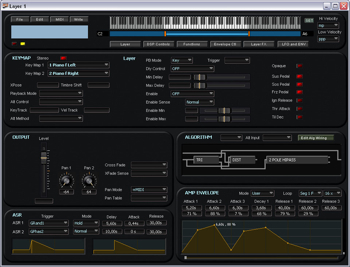 Nous avons testé un PC361 en OS V1.31. Les utilisateurs desWe have tested one PC361 in OS V1.31. Users of former Kurzweil machines will have an easy time grasping the PC3. The screen, which is the size of the series K2000, represents some kind of progress in comparison with the PC2, but still seems small by today’s standards, especially considering that the PC361 is currently one of the most deep synthesizers on the market… fortunately, the ergonomics are good in regard to the complexity. Notable are the 6 buttons of associated functions allow an easy navigation between the Edit/Exit and clear messages that prompt the user to save data. Specific buttons allow toggling between sound layers or midi channels. Nicely done!
Nous avons testé un PC361 en OS V1.31. Les utilisateurs desWe have tested one PC361 in OS V1.31. Users of former Kurzweil machines will have an easy time grasping the PC3. The screen, which is the size of the series K2000, represents some kind of progress in comparison with the PC2, but still seems small by today’s standards, especially considering that the PC361 is currently one of the most deep synthesizers on the market… fortunately, the ergonomics are good in regard to the complexity. Notable are the 6 buttons of associated functions allow an easy navigation between the Edit/Exit and clear messages that prompt the user to save data. Specific buttons allow toggling between sound layers or midi channels. Nicely done!
As always, parameters are displayed in real life value. Times in seconds, levels in dB, frequencies in Hz, etc… thank you! Quick Access allows organizing programs / setups by groups of 10 for instant visualization and easy access. Combined with the category, bank and program selection buttons, it is easy to navigate amongst the 2048 programs in memory. When selecting a program, the screen displays the sound layers used as well as an approximate indication of their keyboard range. Of course, the recent competing workstations have a total graphic representation of the keyboard and the layers, filter profiles and envelope curves, diagrams of the modulation matrix… in comparison the graphic interface of the Kurzweil seems a little dated, a little like MS-DOS in Windows era! Hopefully Kurzweil released a desktop editor for PC and Mac, developed with the co-operation of SoundTower (see photos).
Legacy Sound
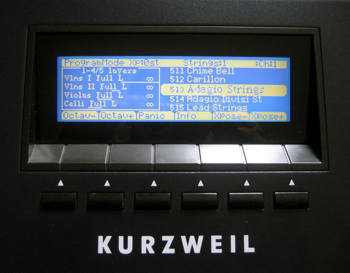 What always hit us with Kurzweil is the ability to put huge instruments in ridiculous memory size. Famous are also the voice-stealing algorithms (when maximum polyphony is attained) and smooth voices allocation, that always gives the impression that there are a lot more voices playing than there are in reality. The PC361 does not escape the rule. The sounds originate from a compressed Rom of 64 MB. The musicality of this Rom, which became legendary through the years, is unanimously praised: part of the initial Rom of K2000/K2500/PC2, Orchestral Rom and Contemporary of the K2500/K2600, Triple Rom Strike Piano and Vintage Electric Piano of the K2600, multisampled jazz voices from the Take-6 CD-Rom… and last but not least the new Rom Strings dedicated to stereo strings sections. The PC361 comes with about 850 factory programs, a good start in life.
What always hit us with Kurzweil is the ability to put huge instruments in ridiculous memory size. Famous are also the voice-stealing algorithms (when maximum polyphony is attained) and smooth voices allocation, that always gives the impression that there are a lot more voices playing than there are in reality. The PC361 does not escape the rule. The sounds originate from a compressed Rom of 64 MB. The musicality of this Rom, which became legendary through the years, is unanimously praised: part of the initial Rom of K2000/K2500/PC2, Orchestral Rom and Contemporary of the K2500/K2600, Triple Rom Strike Piano and Vintage Electric Piano of the K2600, multisampled jazz voices from the Take-6 CD-Rom… and last but not least the new Rom Strings dedicated to stereo strings sections. The PC361 comes with about 850 factory programs, a good start in life.
The excellent piano is presented in different versions, suited for classic piano and modern jazz piano. Our heart raced playing the vintage electric keyboard programs: Rhodes, CP80, Wurlitzer, Clavinet. The modelled tonewheels organs were improved in comparison with the K2500/2600/PC2, but nevertheless don’t quite measure up to certain current B3 softsynths; on the other hand real time control capabilities are a delight. With a variety of new flavours, the basses are much more musical, rounder and easier to mix, with a special mention to the Pull/Slap sounds. The orchestral sounds are outstanding, right in the Kurzweil reputation line, including the following examples: strings sections, solo strings, orchestral ensembles, orchestral solos, orchestral percussions. And don’t forget about the choir, church organ and this Koto that came to our door during the test. The drums are well balanced, with both the meat and potatoes and good variety: acoustic kits, electronic kits, ethnic percussions, tuned percussions. The PC361 is nevertheless less strong in some areas, like acoustic guitars (that date a little) and some brass sounds. At last, the synthesis sounds show the power of the DSP and the sound quality of the PC361, like this compilations of pads, leads, basses et polysynths. The overall PC361 musicality is to die for, thanks to the outstanding hand-made sounds created by Kurzweil’s sound designers, among them the talented Dave Weiser, who used the great tools inside the PC361, of which we will now speak…
When VAST is Dynamic
|
Synthèse VA-1 In 2004 Kurzweil presented the prototype of a virtual analog synth covered with buttons : the VA-1. Alas, in a big financial storm, the company never went beyond this stage. Today, the market has moved and is only addressed by few European manufacturers. The other competitors chose another way, expanding their top notch workstations with optional dedicated synthesis boards. Kurzweil chose a third approach: integrate VA-1 oscillators in its algorithmic blocks. This is a judicious choice for several reasons: first of all VAST synthesis already contains many subtractive synthesis blocks: sophisticated ultra resonant filters, complex envelopes, LFO with Midi sync, mathematical processors, modulation matrix… more than needed. Second, because the digital waveforms originally used in the K2000 (which prefigured in the beginning of the 90’s what virtual analog would be 5 years later) suffered from a large issue: aliasing! Rather impossible to use these oscillators in the upper octaves without being glued in infamous digital glue. This time is defiantly over. Thanks to the brand new VA oscillator blocks, Kurzweil definitively got rid of aliasing: no more digital artefact, the signal remains pure up to the highest keys! It’s a shame you have to combine 2 layers to build up a full virtual analog synth. We wish there would be a template mode using 2 VCO + resonant filter. Kurzweil R&D told us that software company SoundTower was addressing that in their software editor. Well, why not… |
The PC361 is an extremely powerful workstation with 128 voices of polyphony and 16 multitimbral channels. It combines synthesis with high quality samples and 2 types of models: virtual analog (see VA-1 box) and tonewheel organ emulation (see KB3 box). The VAST synthesis first came out almost 20 years ago in the K2000. It is a modular system, allowing combining different signal processing into algorithms: oscillators, filters, shapers, distortions, osc sync… and the ability to modulate everything with a large set of tools: envelopes, LFO, signal generators. The PC3 has expanded the VAST synthesis and Triple Mode of the K2600. It is now called Dynamic VAST, with the ability to cascade 32 layers per program, each with independent algorithms. A layer consumes up 1 or 2 voices of polyphony (mono or stereo); therefore processes can eat up the voices with greediness. Every layer uses a multisample that passes through an algorithm, that is to say an arrangement of several DSP. Think for example of pitch / waveform / filters / shaper / amplifier. There are 28 start-on algorithms and 29 algorithms for cascade mode. Pitch and amplifier are always present at beginning and at the end of algorithms. Pitch manages the frequency (coarse and fine tuning), with keyboard and velocity tracking. The amplifier has same parameters as well but connected to volume.
Dynamic VAST allows to create your own algorithms, comprised of “boxes” which can be 1–4 units in size, depending on the complexity of the units that one wishes to use, not counting Pitch and Amp. A classic synth wave takes 1 unit, a VA-1 waveform takes 2 units, while a 4 pole filter with resonance or separation takes 4. Every unit has access to 1 or 2 ins and 1 or 2 outs. One can therefore connect a unit to (or from) 1 or 2 others modules. This connection can be done with any unit in the chain, not necessarily with adjacent units, thus allowing creation of many combinations in series or parallel. It is huge! And don’t forget that this is for a single layer and that a program can contain up to 32, monstrous! Every layer can play in mono / poly with portamento / legato within a key range and a velocity window, plus sample reading direction, delay, physical controllers response, effects, output level, panning, crossfade… and a demo riff (assignable sequence, see later). But this is not all…
|
KB3 mode
KB3 is a special mode where all DSP resources are used to model tonewheel organ, such as Hammond B3. There are no sound layers as in normal programs. In addition, a KB3 program has full polyphony, the remaining polyphony for other programs depends on number of tonewheels used in the KB3 program: for example, legacy B3 used 91 tonewheels including 12 for the basses. On the PC361, 2 wheels eat up 1 voice, plus 1 voice for the click. 79 wheels eat up (79+1) /2 = 40 voices. You still have 128–40 = 88 voices to play other programs. Good maths again! KB3 uses 2 sets of wheels (inferior and superior), one using generated digital waveforms, the other sampled waveforms (looped samples sound best). This makes it possible to use other than organ sounds, which can give interesting results (choirs are a good when played through tonewheels!). Various types of organ are possible, like vintage or newer simulations. The 9 drawbars can be tunes, which goes far beyond fixed classical footage (16', 5 1/3', 8', 4', 2 2/3', 2', 1 3/5', 1 1/3', 1'). Percussion itself has a big bunch of parameters: volume, decay, harmonic, keyboard tracking, with separate control over soft and loud levels. The click has its own page with control over volume, attack, decay, tracking, threshold and random response. More, you can control Leakage, which is induction crossover effects between adjacent wheels, also called “Bleed”. A good way to dirty up the sound in a more efficient way than a sample sound could achieve, avoiding the effect to change according to keyboard tracking. Various kinds of organs are modelled, depending on the components originally used. At the next stage you can add some vibrato, chorus and EQ, before sending the signal to the effect processor. There you can build up a DSP chain with vibrato + chorus + distortion + Leslie + simulator of cabinet with more than 40 parameters! For live performance, you can easily use the front panel left command section: the 9 faders faithfully reproduce the behaviour of organ drawbars (over 8 or 128 values), the raw of 9 buttons introduce different real time modulations : rotary speaker speed, vibrato speed, chorus, percussion (on/off, volume, decay, harmonic). These parameters can be controlled over Midi or expression pedal. KB3 sounds far better than on previous Kurzweil products but still lacks testosterone. Kurzweil R&D is working hard to improve it, particularly the Leslie simulation. This guys have a big tradition of constant improvements since K2000, so we are confident! |
Modulation Matrix
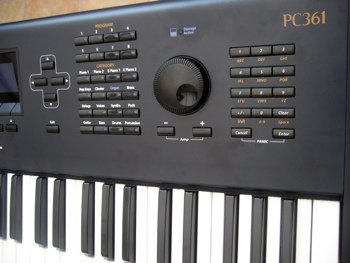 Whatever DSPs are used in algorithms, any parameter can be modulated in real time (physical controllers or control sources). This is done with 2 distinct sources, one of which has a depth control that can be assigned to another source to move between 2 extreme values. Destinations are many and absolutely exhaustive: 2 LFO, 2 ASR, 4 FUN, 3 envelopes, all the physical controllers… The LFO can be sync’ed to Midi clock or can oscillate between 2 controllable extreme values (until 24 Hz, we would have liked more!). They offer 45 complex waveforms and phase control. The ASR are simple envelopes with 3 segments of time (0 to 30 seconds) that can loop, a good way to modulate parameters without using the 3 big envelopes. Next, there are the FUNs, that allow combining 2 control signals into a third one, with more than 50 mathematical functions: addition, subtraction, average, comparison, absolute values, quantisation, trigs functions, Boolean functions… reminding you of your worst maths nightmares! Finally, the 3 envelopes offer 7 segments (time and levels). The amp envelope can be modulated with keyboard tracking and countless other control sources. An impact parameter allows to boost the 20 first milliseconds of the amp envelope in order to add punch to the sound, ideal for punchy attacks. Does everyone still follow? Yes, no, because we’re not finished yet…
Whatever DSPs are used in algorithms, any parameter can be modulated in real time (physical controllers or control sources). This is done with 2 distinct sources, one of which has a depth control that can be assigned to another source to move between 2 extreme values. Destinations are many and absolutely exhaustive: 2 LFO, 2 ASR, 4 FUN, 3 envelopes, all the physical controllers… The LFO can be sync’ed to Midi clock or can oscillate between 2 controllable extreme values (until 24 Hz, we would have liked more!). They offer 45 complex waveforms and phase control. The ASR are simple envelopes with 3 segments of time (0 to 30 seconds) that can loop, a good way to modulate parameters without using the 3 big envelopes. Next, there are the FUNs, that allow combining 2 control signals into a third one, with more than 50 mathematical functions: addition, subtraction, average, comparison, absolute values, quantisation, trigs functions, Boolean functions… reminding you of your worst maths nightmares! Finally, the 3 envelopes offer 7 segments (time and levels). The amp envelope can be modulated with keyboard tracking and countless other control sources. An impact parameter allows to boost the 20 first milliseconds of the amp envelope in order to add punch to the sound, ideal for punchy attacks. Does everyone still follow? Yes, no, because we’re not finished yet…
KDFX Squared
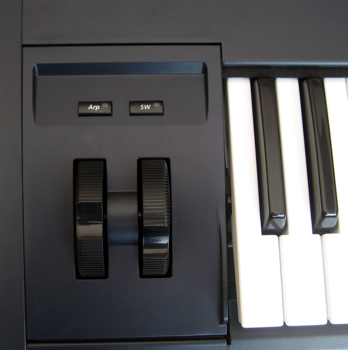
Around 10 years ago, the K2500's optional KDFX expansion allowed the use of up to 5 stereo multieffects with a very smart 8-bus system and unbelievable real time modulations. The sound quality was top notch, which placed Kurzweil well above the competition. But the industry hurried to catch up and it is not rare today to see competing machines with multichannel insert effects along with global effects. Kurzweil had to react and the PC361 effects section is an outstanding response. The machine offers a true studio’s worth of integrated treatments into one compact system. Every program offers 1 chain of insert effects and 2 chains of auxiliary effects with adjustable sends. The insert effects can apply to a whole program, or can be assigned per layer, up to 11 buses. Every chain of auxiliary effects can be applied before or after insert effects, which offers unbelievable routing flexibility. A chain can contain up to 16 units of distinct effects with 15 points of modulation to choose from among all the effect parameters. Among the sources of modulation are 2 LFO, 2 ASR and 4 FUNs, all specific to the effects, impressive! The editor allows to add/subtract boxes at any point in the chain, the only limit being the total power of the DSP (16 units), and the complexity of every effect (1 to 8 units, the most frequent ones consuming 1 to 3 unities).
The list: reverbs, delays (simple, multiples), EQ (graphic / parametric), dynamics processors (single or multiband compressors, expanders, gates), mod effects (chorus, flanger), filters, distortions, Leslie / tremolo / autopan, ring modulation, in mono or stereo. There are thousands of insert effects, hundreds of algorithms, each having access to several tens of parameters. This effects section compares side by side with the better dedicated processors, like Lexicon PCM or Eventide, very big achievement! Where the PC361 hits the nail on the head is multitimbral mode (Setup or Song). In this mode, every track has its own insert effect chain. Note that every effect consumes a certain quantity of DSP resources and that it is necessary to arbitrate between big and small effects. The 2 auxiliary buses are in common and imported from a specified program. Finally, the PC361 includes a global master effects section, with a parametric EQ and a 3 band compressor. If only the PC361 had had audio ins!
Multitimbral Operation
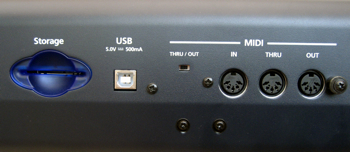 The PC361 has 16 multitimbral channels. Setups mode allow the player to use and manage up to 16 midi zones in independent transmission / reception. The faders allow for easy control of the volumes and other programmed parameters in the modulation matrix, while the colour of the diodes of the row of 9 buttons indicates the channel status (played / muted, the ninth button allowing to alternate between the channel 1–8 and 9–16). Every channel contains info regarding program number, Midi channel, Midi transmission mode (midi, USB, local), key range, velocity window, pan setting, level, effects routing (with override of Program mode settings). One also finds settings of the physical controllers: Pitchbend, modulation wheel, linear faders, pedal, pressure, breath controller, assignable switch, ribbon controller… it only lacks a true graphic representation of the keyboard and different playing zones.
The PC361 has 16 multitimbral channels. Setups mode allow the player to use and manage up to 16 midi zones in independent transmission / reception. The faders allow for easy control of the volumes and other programmed parameters in the modulation matrix, while the colour of the diodes of the row of 9 buttons indicates the channel status (played / muted, the ninth button allowing to alternate between the channel 1–8 and 9–16). Every channel contains info regarding program number, Midi channel, Midi transmission mode (midi, USB, local), key range, velocity window, pan setting, level, effects routing (with override of Program mode settings). One also finds settings of the physical controllers: Pitchbend, modulation wheel, linear faders, pedal, pressure, breath controller, assignable switch, ribbon controller… it only lacks a true graphic representation of the keyboard and different playing zones.
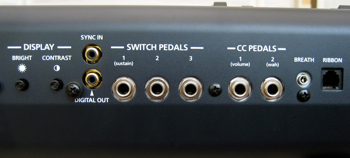 Setup mode is where the arpegiators are programmed and controlled. Every channel can control the internal programs or external units through midi. There are many choices for arpegiator behaviour: up, down, alternated, played, random order, shuffle, walking, with or without glissando… velocity and pressure can modulate sound. After every cycle, the pitch can be shifted. Latching keys can have different actions: stop, continue, add keys… you can lose yourself but without a doubt you’ll never be bored. Different time signatures can be assigned in different zones and all this beautifully synchronizes itself to Midi clock. In today’s workstations, it’s common to find rhythmic patterns and the PC361 does not escape this rule. Every channel offers an independent rhythmic motif, called a riff. A riff is imported from a sequencer track. You can choose which tracks must play, synchronize it to the Midi clock, release it, transpose it (or not), indeed shift it in time, with or without velocity, within an assignable key range. Setup mode offers 2048 locations, including 128 factory setups, capable of playing 16 channels, controlling 16 midi external channels, all while controlling 16 arpeggios and 16 riffs. This is huge!
Setup mode is where the arpegiators are programmed and controlled. Every channel can control the internal programs or external units through midi. There are many choices for arpegiator behaviour: up, down, alternated, played, random order, shuffle, walking, with or without glissando… velocity and pressure can modulate sound. After every cycle, the pitch can be shifted. Latching keys can have different actions: stop, continue, add keys… you can lose yourself but without a doubt you’ll never be bored. Different time signatures can be assigned in different zones and all this beautifully synchronizes itself to Midi clock. In today’s workstations, it’s common to find rhythmic patterns and the PC361 does not escape this rule. Every channel offers an independent rhythmic motif, called a riff. A riff is imported from a sequencer track. You can choose which tracks must play, synchronize it to the Midi clock, release it, transpose it (or not), indeed shift it in time, with or without velocity, within an assignable key range. Setup mode offers 2048 locations, including 128 factory setups, capable of playing 16 channels, controlling 16 midi external channels, all while controlling 16 arpeggios and 16 riffs. This is huge!
Classical Sequencer
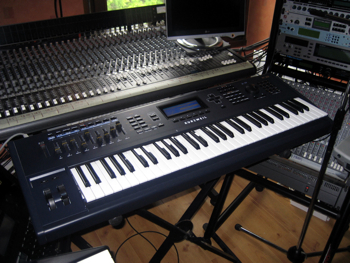 In Song mode the PC361 is at the center of a Midi arsenal thanks to the dedicated USB. Sequencer resolution is roughly 960 bpqn, which we hurried to not verify! Memory is safeguarded when the machine is turned off, Kurzweil being the only brand to our knowledge to allow that, since the K2000. We applaud with 2 hands! The machine provides 16 tracks and 16 midi channels. Every track offers the standard adjustable volume, pan and range parameters, with filtering of the physical controllers. For recording and editing, one finds the standards: punch in and out, loop and overdub, in and out quantisation, multichannel recording, event editing, copy/delete, comparison of the initial sequence vs. the edited version… Nothing but the basics. The interface nevertheless is a little bit dated compared to the big graphic screens of some competitors. You won’t forget your favourite software sequencer, be it in black and white on an Atari (a time that you won’t know if you’re less than 20 years old). The song mode offers 2048 user locations.
In Song mode the PC361 is at the center of a Midi arsenal thanks to the dedicated USB. Sequencer resolution is roughly 960 bpqn, which we hurried to not verify! Memory is safeguarded when the machine is turned off, Kurzweil being the only brand to our knowledge to allow that, since the K2000. We applaud with 2 hands! The machine provides 16 tracks and 16 midi channels. Every track offers the standard adjustable volume, pan and range parameters, with filtering of the physical controllers. For recording and editing, one finds the standards: punch in and out, loop and overdub, in and out quantisation, multichannel recording, event editing, copy/delete, comparison of the initial sequence vs. the edited version… Nothing but the basics. The interface nevertheless is a little bit dated compared to the big graphic screens of some competitors. You won’t forget your favourite software sequencer, be it in black and white on an Atari (a time that you won’t know if you’re less than 20 years old). The song mode offers 2048 user locations.
Conclusion
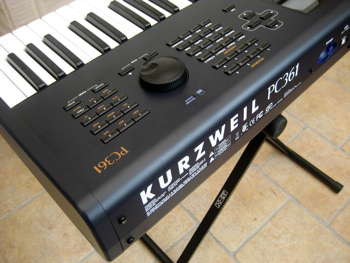 Reviewing the PC361 has been an very nice time. The 61 note version will delight the players who are looking for a compact, more transportable instrument that is still solid. What hit us most strongly was the improved sound quality and increased power in features. The quality of the factory programs is impressive and one welcomes the work of the sound designers. The editing is comparatively easy considering the abyssal depth of the machine, totally modular, even if a big screen and more of graphics would have been welcome. The software editor will satisfy those who are put off by this complexity. The true only grievance is the inability to work with external audio sources (import, sampling, or external signal processing). This is what differentiates the PC3 series from the K series. But considering the impressive range of features, and with sounds that players need, the PC361 is a complete, comfortable workstation in the studio or on stage. A must have!
Reviewing the PC361 has been an very nice time. The 61 note version will delight the players who are looking for a compact, more transportable instrument that is still solid. What hit us most strongly was the improved sound quality and increased power in features. The quality of the factory programs is impressive and one welcomes the work of the sound designers. The editing is comparatively easy considering the abyssal depth of the machine, totally modular, even if a big screen and more of graphics would have been welcome. The software editor will satisfy those who are put off by this complexity. The true only grievance is the inability to work with external audio sources (import, sampling, or external signal processing). This is what differentiates the PC3 series from the K series. But considering the impressive range of features, and with sounds that players need, the PC361 is a complete, comfortable workstation in the studio or on stage. A must have!
VERDICT
Pro
- Excellent musicality
- Top level audio quality
- Total connectivity
- Exceptional modularity
- VA-1 analog modelling
- KB3 modelled organs
- Quality and power of multieffects
- Arpeggios and multitimbral riffs
- Sequencer safeguard memory
- Quality of construction
- Real time controls
- Included editor for PC/Mac
Cons
- No direct graphic edition
- No sampling or audio tracks
- No audio integration over USB
- Basic user manual
Interview with Kurzweil R&D
Thanks to a long-time relationship with Kurzweil R&D members, we were able to set up some interviews with the leading managers and Kurzweil veterans. Some of them are co-founder of the original company and have contributed to design amazing products over the past 25 years. We thank them for their talent, passion and time.
Howard « Hal » Chamberlin – R&D director, hardware manager
AF: In few words, who are you?
Hal: I have been with Kurzweil Music for more than 22 years and before that in the personal computer industry all the way back to before the Altair. I am presently Director of Research and Development in Boston, which is more than a full-time job in itself, but still do a substantial amount of the hardware design and troubleshooting.
AF: How have you been involved in Kurzweil history?
Hal: I joined Kurzweil in 1986 just as the K150 was released and participated quite a bit in the K1000 series development. That was followed by the K2000, PC series, K25/26, and a boatload of digital pianos. I participated heavily in the hardware architecture of most of these and was responsible for the analog audio, power, and user interface circuits. From 1998–2004 I actually lived in Korea and saw to it that what was designed in Boston was faithfully manufactured in Incheon. In the last 3 years, the PC3 dominated that both as an engineer for the first half of that period and as director for the second half while it was being coaxed out the door. I will have to say that the second half, managing, was definitely the hardest.
AF: How did you contribute to the PC3 series development?
Hal: For the PC3 I architected the overall hardware system then went on to design most of the boards. The most important board however – the “voice” of the instrument – was initially designed by Tim Thompson then updated and shepherded into production by Richard Folk. Then as Director I got everything – software, soundware, the manual, etc. – pulled together and finally out the door.
AF: What are you very proud of?
Hal: Playing a pivotal part in the PC3 development is clearly an achievement I am proud of. But a close second has to the original SP88, SP88X, and SP76 line. While certainly not as sexy and groundbreaking as the K2XXX and PC3 series, I engineered these 100%. It was a long-lived, consistent money maker that introduced countless people to the magic of Kurzweil sound at a good price and frankly kept us afloat during many tough years earlier in this decade.
Editor note: One thing that Hal does not mention – Hal wrote a book in the late 70s that was used by every single synth manufacturer from ARP to Roland to Oberheim to Sequential.
https://www.amazon.com/Musical-Applications-Microprocessors-Hal-Chamberlin/dp/0810457687
Tim Thompson – Associate Director and Hardware Department Manager
AF: In few words, who are you?
Tim: I joined Kurzweil Music Systems in April, 1985, working on diagnostics for the K150 Fourier Synthesizer and MIDIboard. I had a company in the 70's doing similar work so I jumped at the chance to come to Kurzweil. I was thrilled to meet Bob Moog when I started working. I bought Switched on Bach when I was 12 years old and brought it to school to show everyone how insanely cool it was. I shared a hotel room with Bob at a NAMM show and got to know him a bit. He was very creative guy, fun to be around, and I miss him a lot. I’ve been mostly a hardware engineer at Kurzweil, starting out working on digital designs and then working on analog audio for the K2600, KSP8, Rumour/Mangler, and PC2. I’ve also managed various departments over the years. When Samick took over and told me I had to move to LA I left to start up Bricasti Design, Ltd. with Brian Zolner and Casey Dowdell. When Hyundai Development Company took over Kurzweil I decided to come back. Although I’m very proud of what Brian and Casey have achieved with the M7, I’m glad to be back at Kurzweil. Now I help Hal Chamberlin manage YCRDI, mostly when he’s not here, I manage the Hardware and VLSI Design department and do some design work every now and then.
AF: How have you been involved in Kurzweil history?
Tim: I’ve had at least a minor role in most Kurzweil products from the K250 on. It’s been hard bringing in so many engineers over the past three years and getting everyone to work together well and functioning as a single, organic whole. Everyone has grown a lot and I’m really proud of our team. I think they’ve done an exceptional job and accomplished far more than I expected. These guys are brilliant and they make me love coming to work.
AF: How did you contribute to the PC3 series development?
Tim: I sketched out a rough PC3 hardware design, but Richard Folk made several improvements, finished it and got it all to work. Richard Bryan made all of the prototypes and kept all of our units working. Mark Miller and Chip Natarajan designed the MARA ASIC at the heart of the PC3. It’s really a great chip that far outperforms any DSP chip that I’ve seen. The whole team worked hard and did a great job working on the PC3.
AF: What are you very proud of?
Tim: I’m proudest of the people I work with: Adam Steinberg, Chip Natarajan, Claude Galinsky, Dave Weiser, Debbie Fieldman, Erick Donoghue, Francisco Rodriguez, Hal Chamberlin, Jean Bellefeuille, Jeff St. Pierre, Jesse Miles, John Richmond, John Teele, Mark Miller, Mike Raffa, Mike Shonle, Ricardo Garcia, Richard Bryan, Richard Folk, C.H. Oh, J.H. Oh, J.S. Kim, Y.G. Lim, Y.K. Lee, and Y.T. Kwon.
John Teele – Software Manager
AF: In few words, who are you?
John: I manage and support our software team, which includes our Waltham-based software engineers, a small handful of software consultants, and (more recently) our overseas software developers in Korea and China. I also contribute directly to the software development process when time permits! I have been working on Kurzweil technology and products for a big part of my professional career – in total over 16 years at this point. Recently I have developed consumer electronics products for Bose, Lexicon, Mark Levinson and others. As a side effect of doing this work that I love so much, I have learned a great deal about audio and music. As a hobby, in my spare time I provide audio services for local bands, including live sound reinforcement and demo recording.
AF: How have you been involved in Kurzweil history?
John: I originally started working at Kurzweil Music Systems in 1987 and was with Kurzweil/YCRDI until they downsized in 2002. I was hired again in 2008 to manage the software team. When I first started I was very new to synthesis and music. I played bass in a small local band “Bridge Street” and my only synth was a lowly Casio CZ-1000. I started working on software updates for the K250 which was pretty amazing to me at the time. Working with Ray Kurzweil was nice, but even better was working with Bob Chidlaw who is the real genius behind the Kurzweil technology and still a friend today. Having said that, it was of course a team effort and we all had parts to play. I helped a bit with the K1000 series, but my first big contribution was developing much of the UI and application layer software for the K2000 series. After that I continued to work on the various spinoffs, K2500, K2600, and ksp8. It was interesting for me to spend a few minutes reading the K2600 user guide recently and remember all the features that we had implemented!
AF: How did you contribute to the PC3 series development?
John: I have helped my team to release some significant software updates for the PC3. But I did not contribute much directly to the PC3; it was started after I was gone and was shipping before I was back. Since the feature set of the PC3 is very strongly based on the K2600, my work in the past did have some impact on the PC3. But at this point my biggest contribution is to help my team to work smoothly together and within the larger organization.
AF: What are you very proud of?
John: Technically I am proud of how well VAST has stood the test of time. I am feeling inspired to lead my team to create the next generation of Kurzweil synthesis technology. Personally I am very proud of my two daughters who are in high school and are both excellent students.
John Richmond – Chief Soundware Engineer and Soundware Department Manager
AF: In few words, who are you?
John: I joined Kurzweil in 1994, as an intern to work on Version 3 of the K2000. I worked on a couple dozen products throughout the nineties until the hammer fell under Samick in 2004. At that point I worked with my good friends at Synthogy, creators of the virtual piano instrument “Ivory” for two years until I rejoined Kurzweil in 2006 to start the PC3 development. I was part of a group of three of us (including Dave Weiser and Mike Papa – former National Sales Manager) who shared the Product manager position, which ultimately determined the feature set for the PC3. I’m currently working on Sound ROM development for our next generation of synthesizers, as well as improving the architecture to support more musical modelling.
AF: How have you been involved in Kurzweil history?
John: Having been here through the K series development meant working with many great people who are engineers and musicians. There have been several mentors: Joe Ierardi, and Geoff Gee from Soundware, Bob Chidlaw (former chief scientist), John Teele and Hal Chamberlin just to name a few. What is hard to explain is that these people and several more shared a passion about making great sounding instruments. After the Samick takeover, it was a real challenge to put the pieces of the company back together to make the PC3 over the last 3 years. This was an entirely new group of people, particularly in software, and technically this is very complicated stuff. Still I was very confident that the PC3 could sound great, knowing the elements that it is comprised of. I’ve worked on the K2500, 2600, PC2 series and all the Effects Processors that Kurzweil has made, so I knew that our sound library going through our new MARA ASIC, with the culmination of all those Effects would be an opportunity to really make this instrument speak, or rather sing! Fortunately, everyone else here shared that vision, and worked very hard to make it a reality. I’m very happy now because we can focus our attention towards a new generation of instruments that will surpass what has been done.
AF: How did you contribute to the PC3 series development?
John: Mostly by managing the team of Soundware engineers to create the soundset that the PC3 has. We have a small team with great talent. Also product management became crucial as an incredible deadline loomed. As soon as I came back to Kurzweil on 2006, I had a very strong vision of what the PC3 would be. It started back then designing the front panel, getting the first sounds from our new chip, then working with software to make use of the features of the new chip as well as recreating some of the good stuff from our past. From that point on, the entire group started creating something new and unique. By pulling the DSP from the never released Virtual Analog Synth, and combining it with a new version of V.A.S.T, it really opened door to sonic creativity. I’m very happy with the end result, and I feel we’ve just started to scratch the surface of what we can do with this technology.
AF: What are you very proud of?
John: The fact that Kurzweil is still making musical instruments. There were very dark days in 2004, and most everyone thought Kurzweil was going to follow in the steps of some of the analog fossils. Through the perseverance of a very dedicated few individuals with a drive that wouldn’t stop until it was right, we have brought Kurzweil back. I’m very proud of the diversity of sounds, and in particular the detail of programming that makes the PC3 capable of recreating classic sounds from classic recordings to the full range of orchestral sounds. When I hear people say that a particular sound makes them want to play a song or a new musical idea, it really makes me feel like people get what we were intending. I look forward to hearing what others can do with a PC3 as well!
David Weiser – Senior Product Manager and Soundware Designer
AF: In few words, who are you?
Dave: I am the product manager, resident keyboardist and lead sound designer for Kurzweil R&D. This is the coolest job in the world. ![]() In addition to sound design and product development work, I demonstrate at tradeshows, I represent Kurzweil publicly on internet forums, and I have good amount of contact with distributors, dealers and hundreds of customers. I genuinely enjoy getting to know our customers – they’re an amazing, colourful group – on the whole quite pleasant and very sharp. I grew up in a musical family – my parents were music teachers and play in a symphony orchestra. I studied piano from age 4 through college. I attended Berklee College of Music, where I studied composition and arranging. Before Berklee I studied Russian at George Washington University.
In addition to sound design and product development work, I demonstrate at tradeshows, I represent Kurzweil publicly on internet forums, and I have good amount of contact with distributors, dealers and hundreds of customers. I genuinely enjoy getting to know our customers – they’re an amazing, colourful group – on the whole quite pleasant and very sharp. I grew up in a musical family – my parents were music teachers and play in a symphony orchestra. I studied piano from age 4 through college. I attended Berklee College of Music, where I studied composition and arranging. Before Berklee I studied Russian at George Washington University.
AF: How have you been involved in Kurzweil history?
Dave: I was hired at R&D in 2000 in the soundware department. Early on my tasks were mostly related to cutting up samples for the senior engineers. My first major projects that involved programming sounds were ROM4 for K26 (vintage EPs) and ROM2 for PC2 (Classic Keys). In 2004 YC/Kurzweil was purchased by one of YC’s competitors. Within a few months they decided to lay off most of the engineers – I was one of the 7 engineers who “survived” the layoffs. This was a hard time for me – all of my friends were gone, the VA1 project had been cancelled and our future looked uncertain. Kurzweil went through bankruptcy and was auctioned off in 2006 to Hyundai Development Corp (not Hyundai Auto – it’s a separate offshoot company founded by former Hyundai auto guys). After that, things got much better – we were able to hire back some old friends, like John Richmond and Tim Thompson. More recently we were able to hire back John Teele to oversee the software department. I cannot begin to tell you how happy I am to have these people here, along with some of the incredibly talented new people we now have at R&D. I am thankful daily to have the privilege of working here with such an outstanding group. These people are the best and brightest… and I’m honoured to be able to call them friends. Kurzweil has opened many doors for me outside of the office as well – I’ve had the good fortune of being able to work with some amazing artists. The two highlights for me were working on the last David Bowie tour and having the chance to design the piano sound for Brian Wilson’s SMiLE album. (That piano sound is now included in the PC3 – program # 15.)
AF: How did you contribute to the PC3 series development?
Dave: I designed a good portion of the PC3's sound set, including pianos, vintage keys (EPs, clav, mellotrons, KB3), synths, some basses and some drums and percussion. My favourite programs are the Ray Charles Wurly, the Steel Drums (synthetic, not sampled) and the Jaco fretless bass. I also helped in the development process, having contributed to the front panel design, spec and feature list.
AF: What are you very proud of?*
Dave: I’m proud whenever I see the PC3 being used on stage, on television, etc., especially when it’s being used by one of my favourite artists. The best example of this was when I set up my all time favourite player, Bernie Worrell (Paliament/Funkadelic, Talking Heads) with a PC3 and watching him have so much fun while playing it. It was truly amazing to watch the PC3 grow from an abstract idea in a meeting room into a real product being written about in magazines, being played by musicians all over the world.
AF: What product / technology development are you currently working on?
Dave: Naturally I cannot say too much… We will be releasing the PC3LE over the summer. Think of it as the PC3's “little brother”. The LE will have the PC3 sound set and PC3 engine – KB3, VA synthesis, etc. Editing will be very limited. It will have half of the polyphony and effects resources of the PC3. The intention was to release a PC3 product with a more affordable price tag, which would open up a broader segment of the market for us.
AF: What are Kurzweil projects?
Dave: Again, I can’t say too much. I usually tell people who ask about the new K that the PC3 is not the last keyboard we’re going to make. We’re going to develop both higher end and lower end keyboards over the upcoming years. We’ve got some unbelievably cool new technology in the pipeline right now – I think the world will be blown away when we unveil it… sorry I can’t say more! Our office in Korea has been working on a line of affordable monitor speakers that sound wonderful, especially considering the low price tag. Also, we’ve been told that the factory is ready to produce a new batch of super ribbon controllers. Those should be available sometime in the next few months.

